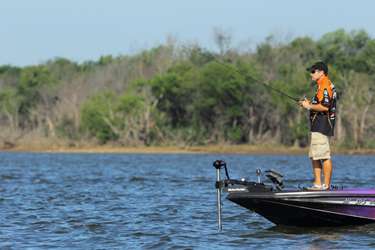
Match the hatch! What fisherman worth his weight in split shots doesn’t know that one?
Well, in addition to mimicking shapes and colors, Elite Series pro Mike McClelland knows it’s also important to match behavior. That’s what makes him such a fan of suspending baits. “Especially in the winter-early spring period, you have to slow down because the fish’s metabolism is so slow,” he said. “That’s what suspending baits allow you to do.”
McClelland said this truth hit him after his early pro years found him very capable of sacking up limits but a little short on big-fish catching ability. That’s when a piece of sage advice from venerable Missouri pro Stacey King facilitated the mental connection that has led him to catches of up to 10 pounds on suspending baits. “He told me, ‘You can’t ever fish too slowly to catch big fish,'” McClelland recalled. “The biggest fish are generally the laziest fish, so suspending baits are the ideal baits for them. Sometimes the smaller fish won’t react [to slower presentations] and that allows the bigger fish time to get to the bait.”
McClelland said one of his prime scenarios for this strategy is late fall and winter on Midwestern and Central U.S. lakes like Bull Shoals and Table Rock. When the clear water breaks the 50-degree mark and starts to fall, that’s when the fish really start responding to a suspending bait. He’ll fish about 3 feet down with a Spro McStick 95 on 10- to 12-pound Sunline fluorocarbon.
The 95 is the smallest in the McStick series, and that’s a good match for the season’s smaller baits. However, McClelland said even a small bait can put on a show. “Even though you’re letting the bait suspend, you want to hit the bait pretty hard,” he said. “It seems like the fish still want a little more action.”
McClelland will also fish suspending baits in the dead of winter on deep, clear waters like Lake of the Ozarks. With temperatures around 40 degrees, the fish will be suspending off the deep drops or submerged timber, so he’ll need to reach deeper with the Spro McRip 85, a diving spoonbill lure that’ll plunge 8 to 12 feet.
McClelland uses 8- to 12-pound Sunline Supernatural monofilament, which suspends with the bait without dragging it any deeper. With a pulling or a sweeping motion, rather than a twitch, McClelland said it’s important to allow the bait more idle time in this situation. Even though you may wind the bait down to 12 feet, there could be a gang of potential takers holding twice as deep. “That’s why you want to let the bait sit longer — to give those deep fish time to commit to coming up in the water column,” he said.
Looking southward to lakes like Kentucky, Guntersville and Toho, where fish stay shallower and don’t get as cold as in the Midwest, McClelland finds good cause for suspending baits in winter-prespawn with water temperatures of 50-plus degrees. Working ledges and grass edges, he fishes a McStick 110 — a shallower diver than the 95 model but with a bigger profile than the McRip.
Again, it’s the patient pauses that turn interest into action. For all his suspending bait duties, McClelland arms himself with a 6-9 Falcon rod that provides good backbone for long casts and a strategically soft tip. That touch of sensitivity, he says, ensures proper bait action and avoids yanking the hooks out of a stuck fish.
In the spring, he uses a Quantum baitcaster with a 5:1 gear ratio because it forces him to slow down, but the rest of the year, a 6:1 model delivers the right speed. As McClelland points out, factors such as altitude, barometric pressure and water temperature can affect how a bait performs.
That’s why he suggests observing baits in the water next to the boat and checking their attitude before sending them into battle. When adjustments are needed, upsizing or downsizing hooks and split rings or adding Suspend Dots are the usual fixes.
“Every day you hit the water with a suspending bait, it’s essential to make sure the bait is doing what you want it to be doing,” McClelland said. “You want to physically watch what that bait’s doing before you start casting and retrieving it. You’re wasting your time if you don’t.”





